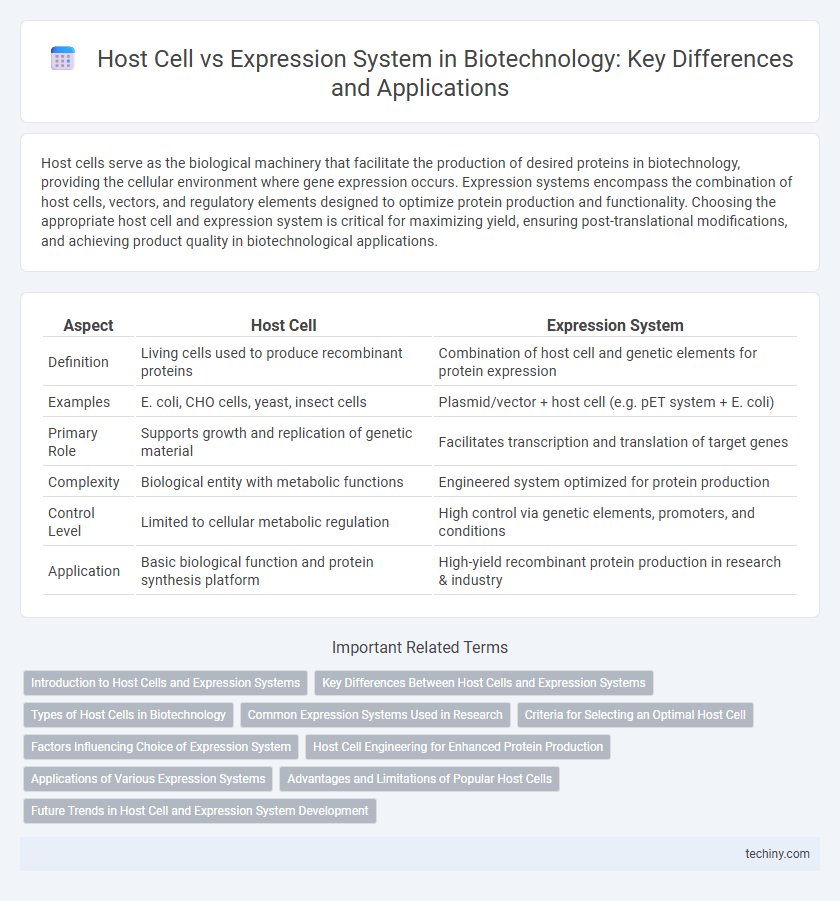Host cells serve as the biological machinery that facilitate the production of desired proteins in biotechnology, providing the cellular environment where gene expression occurs. Expression systems encompass the combination of host cells, vectors, and regulatory elements designed to optimize protein production and functionality. Choosing the appropriate host cell and expression system is critical for maximizing yield, ensuring post-translational modifications, and achieving product quality in biotechnological applications.
Table of Comparison
| Aspect | Host Cell | Expression System |
|---|---|---|
| Definition | Living cells used to produce recombinant proteins | Combination of host cell and genetic elements for protein expression |
| Examples | E. coli, CHO cells, yeast, insect cells | Plasmid/vector + host cell (e.g. pET system + E. coli) |
| Primary Role | Supports growth and replication of genetic material | Facilitates transcription and translation of target genes |
| Complexity | Biological entity with metabolic functions | Engineered system optimized for protein production |
| Control Level | Limited to cellular metabolic regulation | High control via genetic elements, promoters, and conditions |
| Application | Basic biological function and protein synthesis platform | High-yield recombinant protein production in research & industry |
Introduction to Host Cells and Expression Systems
Host cells serve as the biological environment for gene expression, providing the molecular machinery necessary for protein synthesis. Expression systems, encompassing both the host cell and vector components, enable controlled production of recombinant proteins via introduced genetic material. Selection of appropriate host cells, such as bacterial, yeast, insect, or mammalian cells, critically influences protein yield, folding, and post-translational modifications essential for biotechnological applications.
Key Differences Between Host Cells and Expression Systems
Host cells are the living organisms, such as bacteria, yeast, or mammalian cells, that provide the biological environment for gene expression, while expression systems encompass the host cell combined with the vector and regulatory elements used to produce the desired protein. Key differences include the scope, where host cells refer solely to the cellular organism, whereas expression systems refer to the entire engineered setup enabling protein synthesis. Host cells determine factors like post-translational modifications and growth conditions, whereas expression systems influence expression levels, vector compatibility, and overall yield efficiency.
Types of Host Cells in Biotechnology
Common types of host cells in biotechnology include bacterial cells like Escherichia coli, yeast cells such as Saccharomyces cerevisiae, mammalian cells exemplified by Chinese Hamster Ovary (CHO) cells, and insect cells like Spodoptera frugiperda Sf9. Each host cell type offers distinct advantages for gene expression, including growth rate, post-translational modifications, and ease of genetic manipulation. Selection of the appropriate host cell depends on the desired protein product, yield, and functional requirements for therapeutic or industrial applications.
Common Expression Systems Used in Research
Common expression systems used in biotechnology research include bacterial hosts like Escherichia coli for rapid protein production, yeast such as Saccharomyces cerevisiae for eukaryotic protein expression, and mammalian cell lines like CHO (Chinese Hamster Ovary) cells for complex post-translational modifications. Each host cell offers unique advantages in scalability, expression efficiency, and fidelity of protein folding and modifications essential for therapeutic protein development. Selection of an expression system depends on the desired protein characteristics, including solubility, activity, and glycosylation patterns.
Criteria for Selecting an Optimal Host Cell
Selecting an optimal host cell for biotechnology applications depends on factors such as compatibility with the gene of interest, capacity for post-translational modifications, and scalability of expression. Host cells like E. coli excel in rapid growth and high-yield protein production but lack complex glycosylation pathways, while mammalian cells provide accurate protein folding and modifications essential for therapeutic proteins. Stability, ease of genetic manipulation, and regulatory acceptance further influence the choice between prokaryotic and eukaryotic expression systems.
Factors Influencing Choice of Expression System
Selection of an expression system depends on factors such as protein yield, post-translational modifications, and scalability. Host cell compatibility with recombinant DNA, ease of genetic manipulation, and cost-effectiveness play critical roles in optimizing protein expression. The choice also considers regulatory requirements and the complexity of the target protein's structure and function.
Host Cell Engineering for Enhanced Protein Production
Host cell engineering enhances protein production by modifying the host cell's genetic and metabolic pathways to optimize expression system efficiency. Targeted genetic modifications in Escherichia coli, Saccharomyces cerevisiae, and CHO cells improve folding, post-translational modifications, and secretion of recombinant proteins. Advances in CRISPR/Cas9 and synthetic biology enable precise control over host cell machinery, significantly boosting yield and product quality in biopharmaceutical manufacturing.
Applications of Various Expression Systems
Bacterial hosts like Escherichia coli are widely used for rapid, cost-effective production of recombinant proteins in research and industrial enzyme manufacturing. Yeast expression systems, such as Saccharomyces cerevisiae and Pichia pastoris, enable post-translational modifications suitable for vaccine development and therapeutic protein synthesis. Mammalian cell lines, including CHO and HEK293, provide complex protein folding and glycosylation essential for monoclonal antibody production and biopharmaceutical applications.
Advantages and Limitations of Popular Host Cells
Escherichia coli is widely favored for recombinant protein production due to its rapid growth, ease of genetic manipulation, and cost-effectiveness, though it lacks the ability to perform complex post-translational modifications. Yeast expression systems, such as Pichia pastoris, provide eukaryotic post-translational processing and higher expression levels but may introduce hyperglycosylation patterns that affect protein function. Mammalian host cells, including CHO cells, enable authentic human-like processing and proper folding, offering superior protein quality at the expense of slower growth rates and higher production costs.
Future Trends in Host Cell and Expression System Development
Advancements in host cell engineering and expression system development are driving increased efficiency and scalability in biopharmaceutical production. Innovations like CRISPR-based genome editing and synthetic biology enable precise manipulation of host cells such as CHO, yeast, and E. coli to enhance protein yield and quality. Future trends emphasize integrating machine learning algorithms for optimizing expression conditions and developing novel hosts tailored for complex biologics synthesis.
host cell vs expression system Infographic

 techiny.com
techiny.com